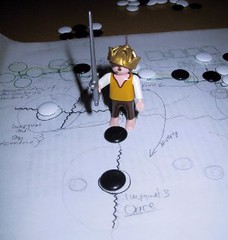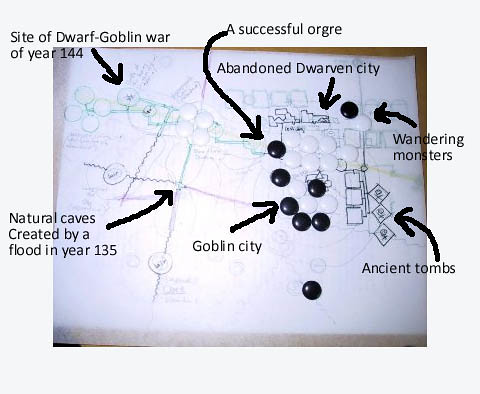From the Division of Lonely Fun*
Today I worked out a little solo play dungeon creation game using tracing paper, tape, different colored pens, and Go stones.

The game uses a mix of random tables, mechanic interactions, and player choices to drive the evolution of the dungeon environment. Dungeon history is divided into epochs. In the Dwarven epoch, for example, a large Dwarven city dominates the dungeon. in the Age of Monsters, the city is abandoned and small monster bands vie for supremacy and resrouces. The game produces two artifacts, a dungeon map, and a history log.
The dungeon map is created on successive sheets of tracing paper. Each layer corresponds to a historical epoch. During each epoch, monsters and civilizations move in and repurpose the artifacts of previous eras for their use. In a paritcular era the dungeon map will typically show groups of creatures, relations between them, regions under their control, major treasrues, tunnels, and landmarks.

The chronology is a record of all the events occuring during the game, like so:
You can review the whole log from playtest 1 here.
* I'm not sure who coined the phrase "lonely fun". It's a mostly perjorative term for solo-gaming in the absence of a gaming group, but it's one I like to appropriate to cover all kinds of solo-gaming.
Update: This game is now called How to Host a Dungeon, and it has it's own Web page: http://planet-thirteen.com/Dungeon.aspx.

The game uses a mix of random tables, mechanic interactions, and player choices to drive the evolution of the dungeon environment. Dungeon history is divided into epochs. In the Dwarven epoch, for example, a large Dwarven city dominates the dungeon. in the Age of Monsters, the city is abandoned and small monster bands vie for supremacy and resrouces. The game produces two artifacts, a dungeon map, and a history log.
The dungeon map is created on successive sheets of tracing paper. Each layer corresponds to a historical epoch. During each epoch, monsters and civilizations move in and repurpose the artifacts of previous eras for their use. In a paritcular era the dungeon map will typically show groups of creatures, relations between them, regions under their control, major treasrues, tunnels, and landmarks.

The chronology is a record of all the events occuring during the game, like so:
139: New Grandash attempts to raid Red Iron Colony, but are driven off.
New Grandash is abandoned, with Red Iron Dwarves looting its treasures
(such as they are).
140: Stendec the Minotaur attempts to set up a lair in Red Iron territory,
but is driven off with some loss of life.
141: Tupelo’s Goblins found a camp in the old Dwarven workshops. They
quickly expand their territory, discovered a cache of Dwarven gold.
Stendec raids the goblins for food in the winter. Red Iron Dwarves
send a raiding party after the Minotaur, but only succeed in driving
him out of his lair to another location.
142: Drawn by rumors of monsters and gold, a party of five brave
adventurers enters the underground.
You can review the whole log from playtest 1 here.
* I'm not sure who coined the phrase "lonely fun". It's a mostly perjorative term for solo-gaming in the absence of a gaming group, but it's one I like to appropriate to cover all kinds of solo-gaming.
Update: This game is now called How to Host a Dungeon, and it has it's own Web page: http://planet-thirteen.com/Dungeon.aspx.
Labels: design, dungeon crawl, lonely fun
Probably the first time I've commented here, but I find this concept incredibly interesting! The idea of a dungeon developing along logical paths as you've described a great way to give them life. Plus, random tables are fun! Very cool!
Posted by grinnock |
9:51 PM
grinnock |
9:51 PM
Thanks! I'm glad someone else finds this idea as interesting as I do. For a long time this has been the cool idea that I secretly think no one but me cares about.
I'm not sure that my implementation is all that great, but I've decided to put it out on the Web anyway. I'll probably rev it eventually when I figure out where it can best be improved.
Posted by Unknown |
10:06 PM
Unknown |
10:06 PM
Looks pretty good from my skimming. I'll try to set some time away to try and run through this myself!
Posted by grinnock |
11:21 PM
grinnock |
11:21 PM
An interesting take on the theme of having fun creating dungeons and histories for campaigns. I do a similar thing using RISK rules with my campaigns sometimes, but yours is a bit more free-form in terms of the creation of maps on the fly. I will try to give it a playtest sometime soon
Roger
Posted by RogerT |
11:57 PM
RogerT |
11:57 PM
Very sweet. Will we see some progress on this?
Posted by Anonymous |
10:50 AM
Anonymous |
10:50 AM
I think you will. I made some preliminary sketches today for a stab at a version 2. I want to make the play deeper, but not more complex, and I've got an idea how to do it. Plus we just got the new season of Dr. Who on DVD, and this will give me something to playtest while I watch TV. :)
Posted by Unknown |
1:35 PM
Unknown |
1:35 PM
I think this has a lot of potential - at least for crazy people like me who love making maps, but hate making dungeons out of whole cloth.
Here is the resuls of my first attempt at 'playing' the DDG. Hoepfully i'll get to test it out in D&D in a couple weeks.
Posted by Sempiternity |
7:35 PM
Sempiternity |
7:35 PM
Awesome! Can I use that image if I make a Web page for this game? I've just completed notes for a new monster group, the surface kingdoms, and a new arch villain, the Mind Flayer Cult. Now to test...
Posted by Unknown |
11:59 AM
Unknown |
11:59 AM
Sure - go right ahead!
Posted by Sempiternity |
12:51 PM
Sempiternity |
12:51 PM
The file isn't showing up on the site anymore. Are you hosting it anywhere else? It looks cool!
-Chris
Posted by Chris Bennett |
2:14 PM
Chris Bennett |
2:14 PM
Whoops! My mistake. The game is now called "How to Host a Dungeon", and it's got its own Web page here:
http://planet-thirteen.com/Dungeon.aspx.
I'll update the post so people can find it. I'm also wrapping up a print version that I'm going to bring to Gen Con with me.
Posted by Unknown |
3:18 PM
Unknown |
3:18 PM